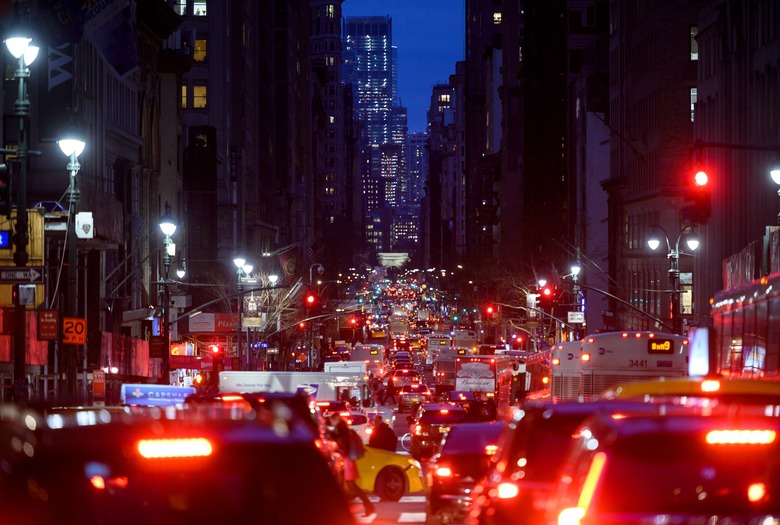How Congestion Pricing May Curb New York's Pollution Problem
New York City's population now exceeds 8.6 million residents, many of whom consider driving in the city to be simply unreasonable – and basically impossible, anyway.
Even so, enough drivers take to New York roads each day to cause maddening traffic congestion and pollute the city's air. In fact, every year, motor vehicles (and primarily buses, cars and trucks) contribute about 11% of local PM2.5 emissions and 28% of nitrogen oxide emissions in New York, according to the city government's web page.
But that's all about to change – hopefully. New York is set to become the United States' first city to charge drivers for releasing planet-warming pollution from their vehicles.
A New City Law
A New City Law
On March 31, New York Gov. Andrew Cuomo (D) and state lawmakers finalized a $175 billion state budget, which included a congestion pricing plan, as reported by ClimateWire, and reprinted by Scientific American. When enacted in 2021, this plan will mandate that drivers pay at least $10 to drive below 60th Street in Manhattan – the busiest part of the city. Specific fee amounts are expected to range from $12 to $14 for cars, and cost about $25 for trucks.
New York League of Conservation Voters President Julie Tighe told ClimateWire that the congestion pricing plan will benefit the city and the environment in several ways. Driver fees will funnel into repairs for New York's public transit systems. Specifically, they will break down as follows: 10% to the Long Island Rail Road, 10% to metro North and 80% to New York City's bus fleets and subways.
This should help break up Manhattan traffic and reduce emissions from vehicles in the city. Reducing air pollution may in turn reduce rates of asthma among low-income and marginalized communities.
"It's a really big win for the environment and mass transit here," Tighe told ClimateWire.
Will It Work?
Will It Work?
New York might be the first city in the U.S. to implement congestion pricing, but it's not the first in the world. Hundreds of European cities use congestion pricing or enact low-emission zones in their city centers, and as a result benefit from improved air quality and traffic flow, according to Science Daily. The reasoning is simple: Congestion pricing discourages driving, and less driving results in fewer vehicle emissions.
For example, Stockholm, Sweden, enacted a congestion tax on Aug. 1, 2007, following a six-month trial period in 2006. ClimateWire reported that the city thereafter saw a 15% reduction in particulate matter and a 50% reduction in asthma rates.
London, England, also imposes a congestion charge of about $15 per day for each vehicle driving within the related zone between 7 a.m. and 6 p.m., Monday through Friday. This charge has been around for more than 15 years, in which time the number of vehicles driving into Central London has decreased by about 25%. For private cars specifically, the number entering Central London fell by 39% between 2002 and 2014, according to CityLab.
Cecil Corbin-Mark, West Harlem Environmental Action's deputy director, told ClimateWire he hopes other U.S. cities follow in New York's footsteps.
"New York City can set an example for other cities across the country, many of which can find their own asthma belts, probably not too far from their central business districts," he said.
References
- CityLab: London's Congestion Charge is Showing Its Age
- Transport for London: Congestion Charge
- Scientific American: New York Looks to Congestion Pricing to Control Pollution
- Science Daily: Road Pricing Most Effective in Reducing Vehicle Emissions
- ClimateWire: Take a Hike, Drivers. Manhattan to Charge Over $10 Per Car
Cite This Article
MLA
Swanston, Brenna. "How Congestion Pricing May Curb New York's Pollution Problem" sciencing.com, https://www.sciencing.com/how-congestion-pricing-may-curb-new-yorks-pollution-problem-13718281/. 18 April 2019.
APA
Swanston, Brenna. (2019, April 18). How Congestion Pricing May Curb New York's Pollution Problem. sciencing.com. Retrieved from https://www.sciencing.com/how-congestion-pricing-may-curb-new-yorks-pollution-problem-13718281/
Chicago
Swanston, Brenna. How Congestion Pricing May Curb New York's Pollution Problem last modified March 24, 2022. https://www.sciencing.com/how-congestion-pricing-may-curb-new-yorks-pollution-problem-13718281/
